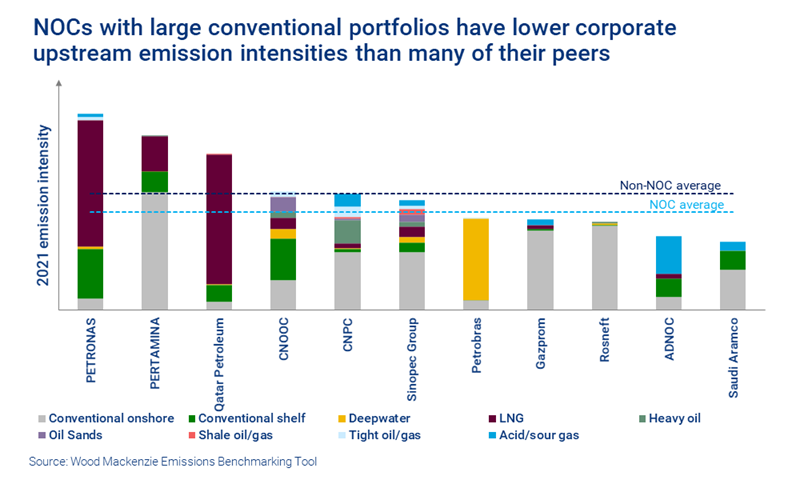The role of NOCs on the road to net zero
Will national oil companies be next to set ambitious emission reduction targets?
1 minute read
NOCs dominate the global oil and gas space – producing 50% of liquids and 48% of gas in 2021. And as some IOCs diversify away from oil and gas as part of their energy transition strategies, this is only likely to increase.
But high levels of production result in high absolute greenhouse gas emissions from upstream activities. Of the almost 100 companies included in our Emissions Benchmarking Tool, NOCs account for nearly half of the top 20 upstream emitters (scope 1 and 2) in 2021, and take the top two spots.
NOCs must play a role in the global mission to decarbonise – could 2021 be a game-changing year?
This article is an introduction to The role of NOCs on the road to next zero. Visit the store to purchase the full report, or fill in the form for a complimentary extract with charts.
Are emissions a key concern for NOCs?
For many NOCs, the primary role is to generate revenue and maximise resource extraction for oil and gas rich government shareholders – and they often have access to some of the best quality and lowest cost resources. NOCs are cash engines for oil dependent economies, generating an average of US$8.20 of free cashflow for every barrel of oil equivalent (boe) in 2021, compared to a non-NOC average of US$6.60/boe. And some governments are reliant on oil revenues for over 90% of government income. So, efforts to reduce emissions, or carbon taxing, are a significant threat.
Despite high absolute emissions, the 11 NOCs covered in our Emissions Benchmarking Tool fare better on an emission intensity basis, and as a peer group have a lower emission intensity than the average.
However not all NOCs are equal, and those with large, long-life conventional portfolios, such as Saudi Aramco and Rosneft, have lower corporate upstream emission intensities than many of their peers. Companies heavily weighted to LNG, on the other hand, have a high scope 1 and 2 emission intensity.
How much of a risk is carbon policy for NOCs?
The trend for carbon policy (such as carbon taxes) and emissions reduction targets is growing. But the risk to many NOCs is low, at least for domestic operations, with most governments unlikely to inflict carbon policy that will impact domestic hydrocarbon revenues.
However, on the back of the Paris Agreement, there is growing global pressure for all countries to set emission reduction targets and policy, and those policy mechanisms may impact imported products as well as domestically produced products. The Carbon Border Adjustment Mechanism proposed under the EU Green New Deal is one such mechanism. Additionally, there is mounting pressure from investors for companies to reduce operational emissions.
High production and absolute emissions expose NOCs to more absolute value at risk if carbon taxes are implemented. We calculate over US$40 billon of value would be at risk for each of the top two NOC emitters if a US$40/tonne carbon tax was applied on scope 1 and 2 upstream emissions (ignoring possible tax effects if carbon pricing was applied on a pre-tax basis). Generally lower emissions intensity and high free cashflow means many NOCs could tolerate extremely high carbon taxes. Of the 11 NOCs analysed, the average carbon tax for upstream company cashflows to breakeven at a 10% discount rate is over US$400/tonne.
What have companies announced?
The NOCs are behind the curve when it comes to emissions reduction targets, with only three having set net zero ambitions: PetroChina, PETRONAS and Sinopec Corp. Many have less ambitious, short term targets and a handful, including Saudi Aramco and Gazprom, are yet to set any corporate targets. Additionally, several NOCs have ambitious production growth targets which will make any absolute emissions reductions challenging.
Last year saw a shift in focus for the European Majors, with all announcing targets to strive for ambitious Scope 1 and 2 emissions reduction targets and carbon neutrality by 2050.
So, are NOCs next? There are several drivers for such a change. Financial risk due to carbon pricing is not the primary one, but increasing stakeholder and investor pressure, the growing marketability of low-carbon products and the physical impacts of climate change are all motivating forces.
And emissions reduction could evolve into lucrative business opportunities, with many of the NOCs already well placed to take advantage. So-called ‘green LNG’, carbon capture utilisation and storage, as well as more low-hanging fruit like reducing flaring and fugitive emissions are all under active consideration by several NOCs.
Will 2021 be a game-changing year for NOCs?
We think 2021 could be a pivotal year, with COP26 in Glasgow in November tipping the balance towards the adoption of further emissions reductions targets. Setting a net zero target may not be achievable or desirable for all NOCs, but those with first mover advantage may reap the rewards of sustainability.
Government decision-makers have a difficult task in balancing NOC cashflows to fund day-to-day spending, maximising extraction of resources in a world moving away from hydrocarbons while also juggling the risks associated with climate change.
The full report uses our Emissions Benchmarking Tool and Lens Direct datasets to explore the role of NOCs on the road to net zero in more detail.
Fill in the form at the top of the page for a complimentary extract which includes an overview of:
- NOCs share of production, in charts
- The growing trend for carbon pricing and emissions reduction targets
- How the NOCs compare to the Majors in terms of emissions reduction targets
- The opportunity presented by carbon offsetting businesses.







